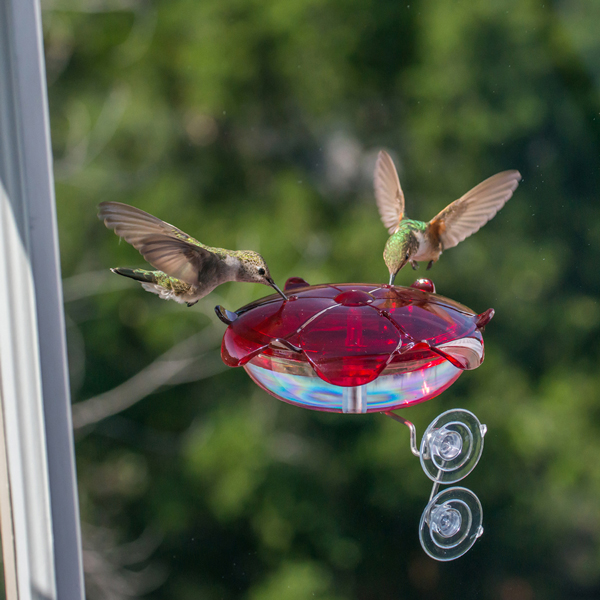
You have done your research and planted a garden full of hummingbird attracting plants such as bee balm and salvia and any other red, purple or pink elongated tube-shaped flower you can find. What is the next step to attract and keep those hummers in your garden? Hummingbird feeders, of course! According to the National Audubon Society, your hummingbird feeder can be a supplemental source of nectar for local hummingbirds and may help them through times when there aren’t as many blooming flowers available nearby.
Hummingbird feeders come in a variety of shapes and sizes. Your choice depends on your personal preferences but some key points to think about when choosing a feeder are as follows. You will need to clean the feeder frequently so choose one that seems easy to clean. Generally, a feeder that has ports above the pool of liquid will drip less and therefore attract fewer ants and bees. It is possible to add an ant moat to help prevent those unwanted visitors. If you have a large yard, consider putting up multiple feeders as hummers are territorial- more feeders will support more birds.
Now that you have selected the perfect hummingbird feeder for your yard, what should you put in it? If you are kitchen-averse, there are many commercially prepared nectar solutions and powders that require little work on your part. It is also very easy to make your own nectar solution using a 1:4 ratio of refined white sugar to tap water. That’s ¼ cup of sugar dissolved in 1 cup of boiling water. Cool the mixture prior to filling the feeder. Never use brown sugar, organic sugar, honey or any other sweeteners as they may have impurities that could potentially harm the birds. No need to add red food coloring to the solution and any unused solution can be stored in the refrigerator for up to a week.
Not only do you want to attract those hummers to your yard, you want them to stay healthy. It is crucial that you change the feeding solution every three to five days. Consider putting your feeder in a shady spot to slow down spoilage.
Feeders must be cleaned between refillings so don’t be tempted to just top them off without cleaning. If the solution starts to look cloudy or if you notice mold, take it down right away and clean it with hot water and vinegar or a mild detergent. Brushes deigned to scrub the feeders and ports are readily available. Consider filling feeders only halfway to reduce waste.
Hummers do not live on nectar alone. Like us, they need a protein source in their diet. Hummingbirds eat insects such as small spiders and flies. Try putting some overripe fruit in a mesh bag to attract fruit flies. You will see your hummers chasing the fruit flies and catching them mid-air.
With so many food sources for hummingbirds in your very own yard, you will be able to enjoy their jeweled presence all summer long.
If you want to do more to help hummingbirds, check out the Audubon Society Hummingbirds @ Home app, found at http://www.hummingbirdsathome.org.









